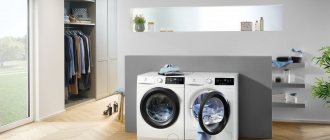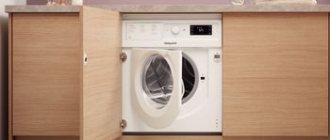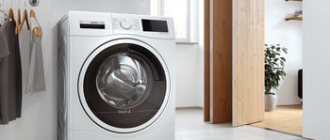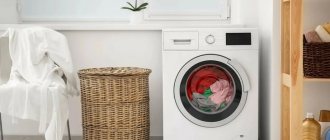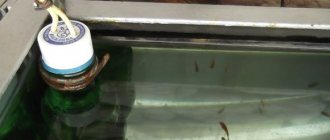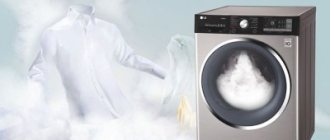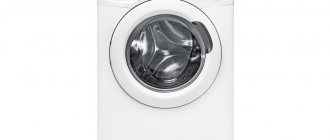About company
The history of the corporation began in 1901 in Stockholm with the emergence of the Lux company, which produced kerosene lamps. Since 1910, the production of motors began. Today Electrolux occupies the place of the world's largest manufacturer - its products are sold not only in the European but also in the American market. Much of the Swedish giant's production capacity was transferred to countries with cheap labor - Poland, China and others.
It is the fact of release outside the country of origin that often causes consumers to have a prejudiced attitude towards the technology. Electrolux came to Russia in 1994. In 2005-2010, a plant operated in St. Petersburg, but was closed - expensive high-quality products could not withstand competition with cheap goods.
Production and assembly of Electrolux washing machines
The company began its history in 1901 under the name "LUX" and produced kerosene lamps. In view of the advent of electricity, the company merged with Elektromekaniska AB, which was developing engines. As a result of the merger, the plant began producing vacuum cleaners.
In 1912, wholesale distribution manager Axel Wenner-Gren was hired. The conclusion of an employment contract with this agent entailed the formation of a new one. After 3 years, the company bought the Elektromekaniska plant and over time, the Electrolux brand included such large-scale giants as Zanussi and AEG.
Today, washing machines are manufactured in Sweden, as well as Italy, China, Poland and Ukraine. It is noteworthy that it does not matter where the equipment is assembled, since management complies with quality standards and monitors the corporate image and reputation.
Washing with SteamSystem technology
Advantages
Electroluxes are equipped with programs that help wash things efficiently. In addition to the traditional modes for cotton or delicate fabrics, there are also ones designed for pillows, linens, sportswear and much more. The machines differ in spin speed - from 400 to 1600 revolutions, as well as in size and capacity - from 3 to 10 kg of laundry. Their advantages over competitors:
- Almost all modifications belong to the highest energy consumption class - “A” and higher.
- Equipping with the latest electronics that simultaneously controls all processes and set parameters from the moment of loading until the completion of the washing process.
- The work is silent thanks to innovative materials, a special shock absorption system and balance control.
- High reliability, safety, high-quality assembly.
- The tanks of Swedish cars are made of carborane. This synthetic material is Electrolux's own development. It combines the properties of stainless steel and polymers. Carborane is capable of storing heat for a long time. It isolates noise well.
Electrolux brand history
Let's start with a short history of the creation and development of the corporation. And it begins in 1901, when the Lux company appeared in Stockholm, which began producing kerosene lanterns. In 1910, the company Elektromekaniska AB was created in Sweden, which was engaged in the production of motors. By this time, business at Lux production had begun to decline as electricity became available, so it was decided to start producing vacuum cleaners rather than lamps.
This production idea interested Axel Wenner-Gren, who worked as a sales agent and decided to work for the Lux company. So in 1912 he began to collaborate with them, and after a couple of years he created his own production under the name Svenska Elektron. The company's affairs began to progress successfully, and then Wenner-Gren acquired the Elektromekaniska company. After another 2 years, he receives an offer to merge with the Lux company. So in 1918, the Ele ktrolux (at first it was written with a “k”).
Elektrolux begins to produce refrigerators and vacuum cleaners, selling them abroad. The war years did not break production. So in 1944 the production of industrial washing machines began, and in 1951 the first household washing machines W20 appeared.
Since 1957, the name of the corporation began to be written with “c” Electrolux. The founder is considered to be the Swede Axel Wenner-Gren.
Electrolux gradually expands production, buying up various companies, and begins to produce dishwashers, electric stoves and compressors. For example, in 1984, the Italian company Zanussi joined Electrolux, and in 1994 the German company AEG.
Today Electrolux is the largest complex for the production of household, professional and garden equipment, with its main office in Stockholm. It has appeared in Russia since 1994. In 2005, a factory for the production of household appliances under this brand was founded in St. Petersburg, but in 2010 it was closed at a loss due to non-competitive prices for the goods. For Russian consumers, automatic machines turned out to be too expensive compared to competitors, despite their high quality. The main consumers of this technology are still the countries of Europe and the USA.
Modern technologies: quality and reliability
In Sweden, only a small fraction of the range of washing machine models that can be seen in the store is produced. Most are assembled at factories in China, Poland, Germany and Ukraine. For example, the manufacturer of the EW 1010 F and EWF 1486 models is Germany. Models EWF 1090 and EWF 1086 are assembled in Italy, machines EWC 1350 and EWC 1150 are assembled in Poland, but models EWF 147410 A and EWF 106410 A are assembled in Ukraine.
Important! The Electrolux company exercises the highest control over production, just so as not to spoil its reputation and fame, so the quality of automatic machines does not depend on the country in which they were assembled.
Thanks to their reliability, Electrolux washing machines can last up to 20 years with flawless operation. In order for equipment to serve people to the maximum and not affect the environment, the manufacturer Electrolux tries to introduce all modern technologies into the models. Thanks to such technologies, the machines have high quality washing. What is it about washing machines?
- Steam System function, which means steam treatment. More expensive models of washing machines have this function. After steam treatment, things are not only easier to wash, even from the most difficult stains, but also smoother more easily. This function can be used either in conjunction with washing or separately to freshen things up. Steam kills germs and allergens, which is also very important and useful.
- My Favorite Plus technology, which means that the machine automatically remembers frequently used programs and functions. As a result, during the next wash, it will offer exactly the remembered programs, which will save time for the user to select; all that remains is to press Start, and the equipment will do the rest. In general, the control of Electrolux machines is very clear; the control panel in Russian is equipped with a display.
- Time Manager function, which allows you to set the washing time manually. At the same time, the shortest program is 14 minutes , during which time it is quite possible to refresh your socks and not twist them for 1.5 hours each time.
- Direct Spray technology uses water and energy based on the load, reducing costs and making washing more economical.
- The auto-parking function in top-loading machines ensures that the drum rotates upward to load things.
In addition to advanced technologies, it is worth noting the large number of programs in machines of this brand. These include not only washing cotton or delicate fabrics, but also washing pillows, lingerie, and sports items. The spin speed in different models can vary from 400 to 1600 rpm. At the same time, spinning at maximum does not damage the fabric and helps speed up drying by 25 minutes. The dimensions and dimensions of the washing machine allow you to wash from 3 to 10 kg of laundry.
Flaws
Reviews from customers and experts indicate that Electrolux products are reliable and durable, but no technology can be perfect. Over time, the following may wear out:
- heating element;
- Water pump;
- Bearings.
Changes in the network negatively affect the control board. Also, after several years of use, the drain hose may need to be replaced.
Self-repair is a fantasy prospect. To get to the seals or bearings you will have to disassemble the entire machine. The cost of repairs is affected by:
- Manufacturer country;
- Type of failure.
The cost of spare parts depends on the manufacturer - for European models they are cheaper than for those produced, for example, in China, Russia, and Ukraine.
SMA Electrolux - whose production?
The manufacturer of automatic washing machines (WMA) "Electrolux" is a Swedish company of the same name. The headquarters of the Electrolux concern is located in Stockholm (Sweden). This company is a true industrial giant. He officially owns dozens of brands, including the world famous AEG and Zanussi. The company is one of the three leaders in the production of household appliances.
New technologies
Sweden is not the only country where Electrolux washing machines are produced. They are also collected in China, Germany, Italy, Poland and Ukraine. All products, regardless of where they are assembled, have a long service life - Swedish machines can regularly wash linen and clothes for two decades. Continuity and long-term sustainability are achieved thanks to the implemented innovative technologies:
- Steam System. Steaming clothes. Thanks to steaming, things are cleaned better - the most corrosive contaminants are removed. The function can be used in parallel with washing or separately to refresh items. The steam kills microbes and destroys particles that can cause an allergic reaction. Steam modifications are more expensive than regular ones.
- My Favorite Plus. The automation remembers the programs and functions that are used most often, and then simply offers them to the user. This saves time - you don’t need to select anything, just click on “Start” and the equipment will start working. The controls are quite simple, the panel is Russian-language. There is a display.
- Time Manager. Time setting function - uses a manual regulator. The shortest duration is 14 minutes.
- Direct Spray. Thanks to this technology, washing becomes more economical - energy and water are consumed taking into account the volume of loaded items.
- Car parking. Top-loading models are equipped with this function - the drum rotates upward when things are placed in it.
Manufacturing countries of Electrolux washing machines
Many of the concern's factories are located in different countries: the USA, Sweden, Romania, Germany, Brazil, Hungary, Poland, Italy, Ukraine and many others.
The information conveyed by the manufacturer is very important for buyers: washing machines and other equipment are produced of the same high quality, regardless of the country of production. According to many reviews, Electrolux washing units last up to 20 years if you follow all the rules for handling them.
Now in Italy, Ukraine, and Poland, front-loading washing units are produced. And the plant in France is famous for its top-loading models.
In Russia, two Electrolux plants recently closed - one in Kaliningrad in 2009, the other in St. Petersburg in 2010 due to financial problems and the 2008 crisis.
Sweden produces a small part of the equipment, mainly for the domestic market. For other countries, there are factories in Poland, China, Ukraine, and Germany. Moreover, each country specializes in the production of “its own” models: EWF 1486 and EW 1010 F are produced in Germany, EWF 1086 and EWF 1090 are produced in Italy, EWF 106410 A and EWF 147410 A are produced in Ukraine, EWC 1150 and EWC 1350 are produced in Poland.
Each washing machine has its own pros and cons, let’s look at them in more detail.
Convenient Features
- Soak. Duration of the program:
- Front loading - 18 hours;
- Vertical - 24 hours.
After soaking, drain and spin or start the next program. For the first 20 minutes, items are washed at 30 °C. Then the heating stops, and the tank rotates, mixing things.
- Direct Spray. Another development of Swedish engineers. The laundry is not washed in water, but only soaked in a solution that is sprayed under pressure. This technology protects fabric fibers from damage. The efficiency of the process is ensured by microprocessor control that regulates the amount of water.
- Eco-Valve. Economical consumption of water and powder. The manufacturer has provided a tight valve to close the drain hole. This allows you to use the powder to the maximum - it does not accumulate in the drain hose.
- Fuzzy Control is a foam control system. The goal is to improve rinsing and reduce water consumption.
- Auto-blocking control. The device itself will detect problems during the spin cycle and try to separate the laundry that has bunched up. If it is impossible to correct the situation, the machine will reduce the spin speed.
- Hand wash. If it is recommended to wash items only by hand, you can turn on this slow mode. The drum will rotate slowly, first in one direction, then, after a pause, in the other.
- Quiet/night mode. At night, electricity is cheaper, which means you can save money. This mode does not have a spin mode; the user must turn it on himself when he wakes up.
Weaknesses of cars of this brand
Washing machines are really reliable, we can judge this from consumer reviews of Electrolux machines, but unfortunately they do not last forever and also break down. What are their weaknesses, how expensive can repairing this equipment cost? As with most washing machines, the Electrolux pump, heating element, bearings can fail, and the control board can burn out due to power surges. During long-term use, the drain hose requires replacement. It may not happen often, but it happens.
In most cases, it is better to contact a professional technician if you have a problem with your machine. Just imagine how you have to disassemble the car to get to the tank, in the center of which the bearings and seals are located. And to get them out of there, you will have to make a lot of effort. Therefore, in some cases it turns out to be easier to use the services of specialists.
As for the cost of repairs, it will depend on what is broken and in which country the car was assembled. Spare parts for European vertical models will naturally be more expensive, and you will have to buy them for euros. Components for Ukrainian or Russian-assembled vehicles will be cheaper. If the inlet hose breaks, you can replace it yourself and for several hundred rubles.
The most expensive repair is the control board, it accounts for up to 40% of the cost of the machine itself.
With proper operation and protection from power surges, board failure is extremely rare, so don’t think that buying a cheaper competitor will be easier and cheaper to repair than Electrolux. An important point in repair is how to determine what is broken? It’s quite simple - look at the display where the error will be displayed, and the decoding of such errors is presented in the article Error codes for Electrolux washing machines.
Review of popular models
Let's look at a few examples of washing machines from Electrolux and their technical characteristics.
ELECTROLUX EWF1408WDL2 is a full-sized washing machine with a maximum load of 10 kg of cotton fabrics, but 4 kg of synthetic fabrics and 2 kg of wool can be washed. When spinning, it accelerates to 1400 rpm, and the speed can be adjusted. It is worth noting that the tank is made of carborane (composite alloy), and there is a built-in backlight in the tank. This model has 14 washing programs, of which steam washing, delicate laundry, and duvet attract attention. Energy consumption A+++, protection against leaks and children is available. Country of origin: Italy, price from 62 thousand rubles.
ELECTROLUX EWT1366HDW is a top-loading washing machine designed for washing up to 6 kg of laundry and spinning up to 1300 rpm. There is a fuzzy logic function and a digital display. All the most necessary washing programs, including the “jeans” mode. Dimensions 89x60x60cm. Country of origin: Poland.
ELECTROLUX EWW51697SWD is a full-size washing machine with a load of up to 9 kg during washing and 6 kg during drying, but this is provided that the machine contains only cotton laundry. For synthetic fabrics, washing load is 6 kg, drying load is 3 kg. After spinning in such a machine, the laundry is almost dry, since the machine accelerates to 1600 revolutions. In total it has 14 programs, including a special water drainage program. The security system is excellent, so in addition to protection against leaks, there is protection against overflow and overheating, as well as self-diagnosis of faults. The country of origin is Italy, the price for a model with this functionality starts from 92 thousand rubles.
Vertical loading
The hatch is located on top. Under the hatch there is a horizontal drum. The door has a conventional mechanical lock. Control panel - on the top or side panel. Minuses:
- The drum of vertical models is less spacious;
- No drying function.
These versions of machines are preferable for small rooms. 98% of devices are produced with a width of 40 cm and a depth of up to 60 cm. They are quite narrow, so they easily fit in small bathrooms. Often vertical machines are equipped with wheels, with which they can be moved from place to place.
Characteristics of Electrolux EWT1064ILW:
| Loading, kg | 6 |
| Energy class | A++ |
| Washing class | A |
| Spin speed, rpm | 1000 |
| Estimated cost, rubles. | 24 000 |
Features of washing machines from Electrolux
The most basic selection criteria are technical and functional characteristics. Size, type of motor and door placement, energy efficiency and spin speed - all these parameters are taken into account when choosing equipment, and subsequently affect the efficiency of the equipment.
From the point of view of economical and comfortable operation, the noise level, water consumption, and the ability to select a certain temperature are also important.
Useful functions will include protective programs that will control foaming, the occurrence of imbalances, and protect children from unwanted consequences due to their careless interference with the operation of the equipment.
Washing machines from the Swedish manufacturer are equipped with a wide range of basic and additional functions that provide excellent washing results and protect the unit from negative influences.
Selecting front or vertical loading type
In addition to the obvious differences, which lie in the appearance of models with different types of loading, their functional features should also be noted.
Machines with laundry loaded from above are more compact - if a full-size front-type device measures 60 by 60 cm, then a vertical type machine with the same loading volume will have dimensions of 60 by 45 cm.
Another advantage of a top-loading type machine is the ability to pause the work process and add things that you forgot to load at the beginning
The type of loading does not have much effect on the durability of the device. The presence of two bearings (in a vertical type machine) or one (in a device with side doors) is not essential for the operation of the washing machine. But the front-type machine is more stable and less susceptible to vibration.
Often the decisive factor when choosing one type of device or another is not personal preferences, but the conditions dictated by the layout of the house or apartment.
So, if the bathroom is very small, then the choice has to be made based on the size of the machine itself and the ability to open the doors freely. If the installation will be carried out in the kitchen, then, in most cases, front-loading appliances are chosen.
Front-loading machines are more popular in the CIS countries. They are suitable for installation in the kitchen, bathroom or combined bathroom
Dimensions of equipment and norms for loading laundry
According to standard size, Electrolux washing machines are divided into:
- Full size. Front-type machines have dimensions of 60 cm in depth and the same width, and full-size vertical-loading machines are produced in dimensions of 60x40 cm.
- Narrow. These include front-type devices, which, with a typical width of 60 cm, are 40 cm deep.
- Compact. With a width of 60 cm they can have a depth of 33.8 to 45 cm.
The load size varies from 3 to 10 kg of laundry. Capacity of 7 kg allows you to provide clean clothes for a family of 5 people or more.
In such a spacious drum you can wash a double blanket or a voluminous blanket, which cannot be done in compact devices
Built-in machines have their own characteristics. This type of equipment is designed for hidden installation. The equipment is “hidden” behind the kitchen unit or under the cabinet in the bathroom. The vibration levels in such devices are subject to more stringent requirements.
Built-in models are equipped with stainless steel mounting loops. Front doors from the furniture set installed in the kitchen are hung on them.
The main qualities that distinguish built-in appliances:
- all devices are full-sized;
- models are available only with side loading;
- The technique has imbalance control.
Compared to standard equipment, the cost of built-in equipment is 2-2.5 times higher.
Narrow washing machines are very popular among owners of small apartments and housing from the old building, called Khrushchev. Compact equipment can provide clean clothes for the whole family, while occupying a minimum of space
Motor type: commutator or inverter
By focusing on the inverter motor, manufacturers of washing machines of various brands, and not only Electrolux, rely on their significant advantages in terms of efficiency and long service life.
But is the price they offer to pay for improved characteristics justified, since on average inverter devices cost 1.5 times more than conventional models?
Inverter models are really economical and use 20% less electricity than conventional ones. Savings are achieved through improved engine performance.
But manufacturers often keep silent about the fact that the main amount of energy resources is consumed not by the engine, but by the electric heater. But the long warranty for the inverter motor is really the factor that justifies the high cost of the models.
The company produces washing equipment with commutator and inverter motors. The second option comes with a ten-year warranty
Additional information about the design and operating features of washing machine motors, as well as the nuances of replacing the motor, is given in this article.
Energy class and speed
The classification of energy consumption is carried out in a letter designation, from A to G. But the constant improvement of technology in terms of saving resources has led to the emergence of equipment with classes A+, A++ and A+++.
Electricity consumption for class A+++ equipment is 0.5–0.6 kW/h. These classes are calculated and indicated in the technical specifications separately for the washing and spinning modes.
Some washing machine models are even more energy efficient. For them, the manufacturer indicates class A+++ -10%, and even -20 and -30% (+)
Washing machines from AB Electrolux can have ram rotation speeds from 600 to 1800 rpm. The more revolutions the drum makes, the more moisture is removed from the laundry, and the less time is required for subsequent drying. Increasing the number of revolutions per minute also has a negative side - it leads to creasing of the fabric.
But this factor can be removed if you use the steam function, and then, perhaps, no ironing is required at all - the fabric will become soft and fresh.
The spin class depends on the rotation speed of the drums. Classification is carried out using letter codes - from A (the moisture content of the clothes after spinning is < 45%) to G (the moisture content is > 90%). A device with a high speed of revolutions (about 1600 per minute) is assigned class A. The most optimal speed is 1 thousand rpm.
The degree of spin directly depends on the rotation speed of the drum, but at the same time reduces the energy efficiency class. Therefore, the most economical machines usually have a low spin class, which does not bother those who want to buy a drying unit in addition to a washing machine.
Front loading
The hatch is located in the center - it’s convenient to stash things. The door rotates 180 degrees. During operation, the hatch is blocked. The latest front modifications can hold up to 12 kg. On the front of the case there is a control panel in the form of a touch screen or regular buttons.
Flaws:
- To put things into the hatch, the user has to bend or squat;
- Once the washing process has started, items cannot be added.
Characteristics of Electrolux EWS1076CI:
| Loading, kg | 7 |
| Energy class | A+++ |
| Washing class | A |
| Spin speed, rpm | 1000 |
| Estimated cost, rubles. | 20 000 |
Model overview
The brand has washing machines for every taste and need. The manufacturer is constantly improving and expanding its range. Let's consider the most interesting and popular versions of frontal, vertical and built-in SMAs. Let's start with something new.
PerfectCare 700 EW7W3R68SI - built-in new product
Built-in front version. A spacious device with electronic control, a drying function and a high energy consumption class - A+++. Protection against leaks is complete. There is foam level control. An inverter motor is installed.
- loading - 8 kg;
- spin speed - 1600 rpm;
- number of programs - 14 pcs.;
- dimensions (WxDxH) - 60x54x82 cm;
- water consumption per cycle - 115 l;
- drying - 4 kg;
- additionally - there is a choice of speed and spin cancellation, wrinkle prevention, super rinse, steam supply, stain removal;
There are no reviews about this new product yet, so let’s see what the manufacturer promises and what the manufacturer focuses on:
- Quiet operation. Indeed, the noise level is almost minimal - 46/70 dB.
- DualCare - having determined the type and weight of the fabric, the system selects the temperature and rotation characteristics of the drum in such a way as to wash each item as efficiently and carefully as possible.
Well, the new product deserves attention - it has all the functions necessary for high-quality and comfortable washing. The only thing that can slow down buyers is the price.
Electrolux EWT 1064 ILW – vertical
Popular top-loading model with medium drum capacity. Designed for 14 programs, there is an “easy ironing” function, which can be used to process shirts and curtains without any problems.
Options:
- loading - 6 kg;
- noise - 57/74 dB;
- spin speed - 1000 rpm;
- number of programs - 14 pieces, including Jeans, Night mode, Stain removal and others.
- dimensions (WxDxH) - 40x60x89 cm;
- water consumption per cycle - 47 l;
- additionally - automatic drum parking, automatic opening of the doors, delayed start up to 20 hours.
Pros:
- Compact dimensions.
- High quality wash.
- The cuvette is not located on the lid.
- Price.
- Simple controls.
- Abundance of modes.
Minuses:
- May make noise during operation.
- There is no drain filter (in fact, there is one, but the housing requires disassembly to clean it).
Electrolux EW6F4R08WU – heavy load
A front-type machine with a sufficient number of programs and an “anti-allergy” mode at an average cost. It has become the “choice of customers” due to its good drum capacity and washing quality.
Characteristics:
- loading - 8 kg;
- noise - 58/79 dB;
- spin speed - 1000 rpm;
- number of programs - 14 pieces, including Jeans, Outerwear, Down items and others.
- dimensions (WxDxH) - 60x55x85 cm;
- water consumption per cycle - 52 l;
- additionally - choice of washing temperature, delayed start up to 20 hours.
Pros:
- Multifunctional.
- Reloading function (during the first 10 minutes of operation).
- Steam treatment.
- Child protection.
- Quiet operation.
This is the case when buyers did not find any shortcomings in the SMA - a good option for those who value the smooth operation of equipment and extensive functionality.
EWT 1066 ESW - the most popular
The vertical SMA wins the popularity rating. Probably, the fashion for the vertical format has reached us - in Europe, vertical formats have long been supplanted by the spectacular, but less convenient to use frontal versions.
- loading - 6 kg;
- noise - 57/74 dB;
- spin speed - 1000 rpm;
- number of programs - 14 pcs.;
- dimensions (WxDxH) - 40x60x89 cm;
- water consumption per cycle - 41 l;
- additionally - selecting the washing temperature, washing blankets, underwear;
Pros:
- compact, takes up little space;
- it’s convenient to store things - many users are tired of bending over to load and unload laundry, and the hatch door, which they constantly hit with their feet;
- protection from children;
- smooth opening of the drum door;
- It’s convenient to wash the detergent tray thanks to its special design;
- presence of a switch for liquid detergents;
- convenient control;
- high-quality washing;
- appearance;
- touchscreen.
Minuses:
- there is vibration, but it doesn’t interfere with sleep at night;
- complaint about defects: due to a crooked casting, the pulley rattled - I had to take the device to the store;
- Poorly washes powder out of trays;
- Some users are unhappy with the sounds the machine makes during operation.
The main drawback noted by users is the noise during the spin cycle. There are theories that the bearings are to blame. In general, not everything is clear with this SMA. Perhaps the Swedes still cannot control their factories located in other countries, especially in Eastern Europe. As a result, buyers, flattered by the “Swedish quality,” are surprised to encounter the most common breakdowns typical of some budget washing machines assembled in China.
Wall-mounted washing machine - what is it?
The wall-mounted model appeared on the market quite recently and has not yet become popular. So far, only two brands have presented such a modification - Electrolux and Daewoo. The first thing that catches your eye is its modest size. That is why these cars have the prefix “mini”. Their cost is about 20,000 rubles. Design differences - there is no pump or sump pump.
Pros of wall-mounted versions:
- Easy installation;
- Space saving;
- Energy efficiency;
- Spectacular design.
Minuses:
- Insufficient quality of washing, maximum class - B;
- The maximum loading volume is 3-4 kg.
Electrolux recently introduced a small wall-mounted modification to the market - it can easily fit in a cramped kitchen or bathroom. The manufacturer produces two “mini” versions: one is built-in, the second is wall-mounted.
Demand rating - TOP-5
Let's try to compare the most popular modifications of Electrolux machines, paying attention to their strengths and weaknesses. All models of the company - frontal and vertical - have impeccable technical characteristics. Therefore, the rating of the most popular units was compiled based on positive reviews from their owners.
First place - EWS 1277 FDW
It is not only high-quality and effective, but also economical. The spacious machine can easily wash a large family. Equipped with full protection against leaks and a solid set of programs. Thanks to the inverter motor, there is almost no noise. Saves energy. Assembled in Italy. The only downside is the rather high cost.
| Loading, kg | 6,5 |
| Energy class | A++ |
| Washing class | A |
| Spin speed, rpm | 1200 |
| Estimated cost, rubles. | 53 000 |
Second place - EWW 51696 SWD
This version, equipped with a drying and steaming function, received almost as many positive responses as the previous one. It is more expensive because it has more capacity. There are three drying programs and 10 different modes. Protection against leaks is partial. Among the advantages we note:
- Quiet operation - practically no noise;
- High build quality;
- Solid functionality, a lot of additional options.
Excellent washer-dryer model. Due to the high cost, it is not available to everyone, which is why it ended up in second place.
| Loading, kg | 9 |
| Energy class | A |
| Washing class | A |
| Spin speed, rpm | 1600 |
| Estimated cost, rubles. | 79 000 |
Third place - EWG 147540 W
Compact built-in model. Front loading. There is no drying. Can be installed in a kitchen countertop. This allows the device to fit harmoniously into the kitchen interior. However, from a practicality standpoint, free-standing models are preferable. Completely protected from leaks. Equipped with 14 washing programs. There is a timer. Advantages:
- Low noise level;
- Vibrations are minimal;
- The brand provides a ten-year warranty on the motor;
- There is a display;
- Solid set of programs;
- Customizable parameters, including temperature and speed;
- There is protection against children.
Flaws:
- Inconvenient adjustment of the rear legs;
- The gap between the door and the drum is too large - small things can fall into it.
| Loading, kg | 9 |
| Energy class | A++ |
| Washing class | A |
| Spin speed, rpm | 1400 |
| Estimated cost, rubles. | 65 500 |
Fourth place - EWX 147410 W
Few washing machines can boast of having a drying function at a low price. The disadvantage is the low energy consumption class. Dries up to 4 kg. Partially protected from leaks. 14 built-in programs. Effectively removes even heavy dirt and lasts a long time. High spin quality.
Minuses:
- At the end of the process, the door does not open - you need to wait a whole minute;
- Upon completion of the process, it emits a piercing squeak;
- You cannot select the spin speed.
| Loading, kg | 7 |
| Energy class | IN |
| Washing class | A |
| Spin speed, rpm | 1400 |
| Estimated cost, rubles. | 47 000 |
Fifth place - EWW 1686 HDW
The overview of the best models is completed by an inexpensive but functional machine - EWW 1686 HDW. Having collected fewer positive reviews, this frontal version, however, surpasses the previous ones in terms of technical characteristics. There is drying. Designed for 7 kg. Partially protected from leaks. It has luxurious functionality - many special programs. But the biggest plus is the ability to dry 7 kg of laundry. Not every model can boast of this. All other characteristics are also exceptional: spaciousness, consumption class - everything is excellent. Italian assembly.
Flaws:
- The panel and instructions are not in Russian;
- The drain pump is too noisy;
- The large depth of the model is 64 cm. If you need to install it in a cramped bathroom, the dimensions can become a problem.
| Loading, kg | 8 |
| Energy class | A |
| Washing class | A |
| Spin speed, rpm | 1600 |
| Estimated cost, rubles. | 67 000 |
Basic criteria for choosing a washing machine
Electrolux - the best washing machines are presented in different models, but have general parameters:
- The type of loading is divided into two types - frontal and vertical.
- Dimensions are presented in two versions - narrow up to 45 cm, classic over 55 cm.
- The capacity of the prevailing representatives is designed to load things up to 6 kg, but there are powerful models with a drum from 7 kg.
- The washing class has 6 types from A to G.
- In terms of control type, the company is based on an electronic version, but previously produced models with manual mode switching.
- The tank is made from two materials - polymer or stainless steel.
Mechanical control type
Electronic control type
